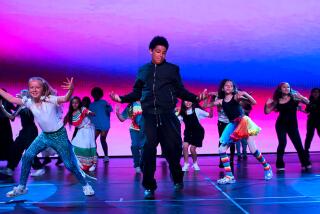MUSIC AND DANCE : Dazzling Acrobatics by Chinese Children
- Share via
Don’t be surprised if you hear a warning for parents and children before the Chinese Children’s Palace of Hangzhou troupe performs Sunday afternoon at the Orange County Performing Arts Center in Costa Mesa.
The dazzling acrobatics and contortions usually prove so irresistible to young children that managers regularly feel impelled to warn them: Don’t try duplicating these acts on your own.
Audiences often laugh. But they soon see the warning’s wisdom. Some child is likely to think it’s pretty easy to climb a tower of precariously balanced chairs, or to balance porcelain bowls while going through pretzel-like contortions, or to hold a dozen spinning plates on his hands and feet while doing a handstand or a somersault.
After all, it looks so easy when the Chinese visitors do it. But that’s part of the illusion.
The 40-member Hangzhou troupe consists of 15 acrobats, 20 dancers and five musicians, ranging in age from 13-21. The average age is 17.
Xin Zhu, the group’s secretary and interpreter, said in a recent telephone interview from a tour stop in Georgia that the most difficult balancing act is one in which a 19-year-old climbs up five circular steel pipes that are balanced in alternating horizontal and vertical positions.
“He has been training for this act for about 10 years,” Xin said. “It is very dangerous.”
Although the acrobats are willing to run risks, they are not fools. “We do use safety wires for the most dangerous acts,” Xin said. “At the end of one balancing act, the main actress will be at the top of the theater and very high on stage. That’s very dangerous. So we put a safety wire on her.”
The wire is there only in case the artist falls. It does not make the climb any easier.
Troupe members come from the Zhejiang Province in southern China and are trained in music, dance, Chinese opera and stage arts at the Zhejiang Art School. The training begins when they are 6 years old, Xin said. “Teachers look for any children who have the ability to develop skills in acrobatics, music and dance--children who can balance well and who can jump well,” he said.
For dancers, the requirements are less strict: “They just have to like very much to dance.”
Although some of the youngsters are children of acrobats and have the benefit of learning from their parents, the majority are not.
“These kids come from many different places in the province and their backgrounds are very different,” Xin said. “Their parents are sometimes workers, sometimes professors at the universities and sometimes also farmers.”
(Xin is concerned that misapprehensions may arise from the name of the troupe. “The name the Children’s Palace was given by our American partners,” he said, “but it is not correct. It gives the people the impression that the children come from a palace. In fact, they are from our school and from a professional acrobatic group. This is just a name for this American tour. The formal name is the Zhejiang Provincial Youth Cultural Arts Delegation.”)
Some of the children will continue to be professional performers, and when they grow too old to perform, many will return to the schools and companies to teach the younger generation.
Some of the balancing acts date back 1,500 years, Xin said.
“But it is less difficult now,” he said. “The human being is becoming more and more intelligent, and, also, we have developed better equipment that is used for the very dangerous balancing acts.”
Not all the acrobatics are ancient; some have been developed fairly recently. The dances, meanwhile, include the perky “Picking Tea Leaves,” the dreamy “Moonlight Ballet of the Tang Dynasty” and a vigorous lion dance.
“‘Sea Fantasy’ combines Western music and Eastern dancing style,” Xin said. “The four girls and six boys use a very large, square handkerchief made of silk--but it’s very, very big--just like the waves of the sea.”
Traveling with the group are five young musicians who accompany the others and perform solos on such Chinese instruments as the yangqin, a hammered dulcimer; sheng, a mouth pipe organ that sounds like a bagpipe; dizi, a flute; pipa, a Chinese lute, and erhu, a two-stringed fiddle.
The company has almost completed its 10-week, 22-state American tour. “So far we have been to 20 states and have performed 37 shows,” said Xin, estimating that 509,000 have seen the troupe so far. “American audiences have been so enthusiastic,” he said, recalling especially warm receptions in Boston (Hangzhou is a sister city of Boston) and in New Jersey (Morris County, N.J., is a sister province of Zhejiang Province.)
“We spend a lot of time on the road,” he added. “Every day as we start out traveling by bus, we sing the song, ‘On the Road Again.’ ”
The Chinese Children’s Palace of Hangzhou performs traditional dances and acrobatics at the Orange County Performing Arts Center in Costa Mesa on Sunday at 3 p.m. Tickets: $10-$25. Information: 556-2121.
More to Read
The biggest entertainment stories
Get our big stories about Hollywood, film, television, music, arts, culture and more right in your inbox as soon as they publish.
You may occasionally receive promotional content from the Los Angeles Times.










